
You might ask why I am bothering to tell you, the avid and good looking sport physiotherapist, what plans we have the website in 2011. Well, I have decided to let you know for two main reasons. The first is because it will affect you guys. 2010 was OK, but 2011 will be awesome! I will expand below. The second reason is that by putting it out there, it serves as a good motivational tool. Plus, you guys can keep me in line. In this post, I will discuss the big goals for the site in 2011.

Patients say the darndest things, they really do. On an almost daily basis I have to stop myself from laughing at some of the things that they tell me, that are not meant to be funny. Whilst it is clearly inappropriate to laugh at them, and I never ever recommend this, I thought I would write this post as a light hearted look at some patient interactions. Below I discuss my 4 favourite statements that patients said to me this week.

Cuboid Syndrome is defined as minor disruption or subluxation of the structural congruity of the calcaneocuboid portion of the mid-tarsal joint (Blakeslee and Morris, 1987). Now, that is quite a wordy definition which essential means the subluxation of the cuboid from its natural position. Whilst you may feel that this condition is rare, it is probably more common than you think, particularly in certain athletic populations. Therefore, for the sports physiotherapist who routinely treats foot and ankle injuries, cuboid syndrome is a condition that you must be aware of. It is frequently misdiagnosed and therefore poorly treated. If you do not look for this it is likely you won’t find it, and your athletes will suffer.
We all know that hamstring injuries are an exceptionally common sporting injury. In some sports, such as Australian Football League (AFL), they have the highest incidence of any injury (Warren et al 2010). Therefore the sports physiotherapist will routinely assess and rehabilitate these injuries. During this process the athlete and coaching staff will frequently demand timeframes of return to training and play. Thus, if you are a sports physiotherapist who treats these athletes you should be acutely aware of the clinical predictors, or prognostic indicators, of return to play timeframes following hamstring injury.

The sports physiotherapist will commonly treat shoulder presentations. One of the most common presentations, particularly in an athletic population, is subacromial impingement syndrome (or external impingement). Therefore, it is essential that the sports physiotherapist be fully aware of the more common contributing factors and treatments for this condition. This article discusses the effect of posterior capsule tightness and the “Diablo Effect” on subacromial impingement syndrome.
The sports physiotherapist will frequently assess and diagnose acute knee injuries. In doing so, we will regularly rely on the results of special orthopaedic or clinical tests. However, if we are going to use these tests to make diagnoses and therefore guide our treatment decisions, it is vital that we are aware of the diagnostic accuracy of clinical tests. This article evaluates the research regarding the diagnostic accuracy of commonly used clinical tests for medial meniscus tears.



